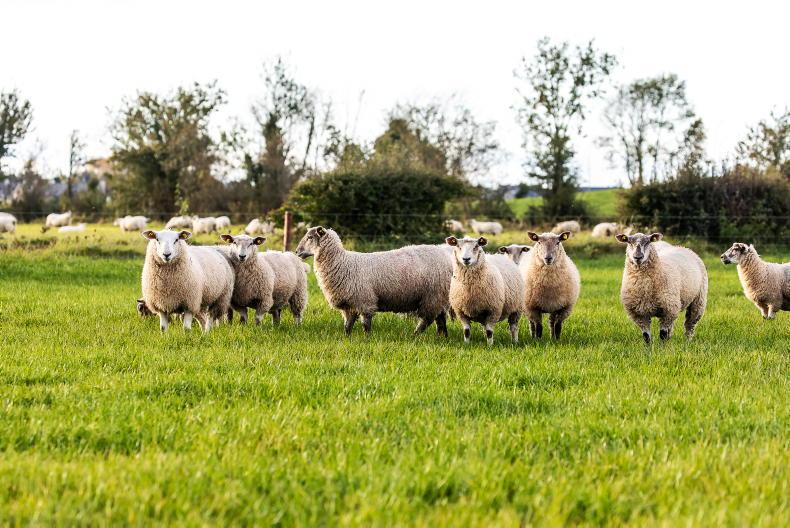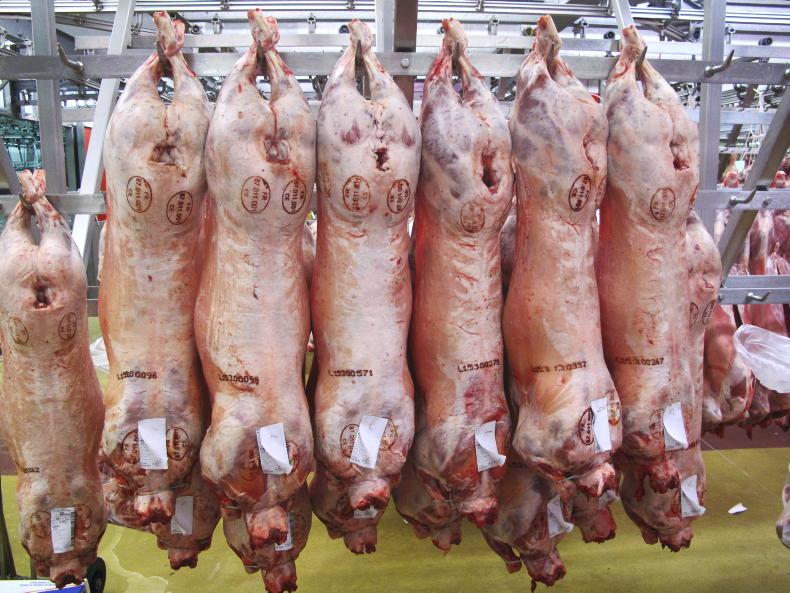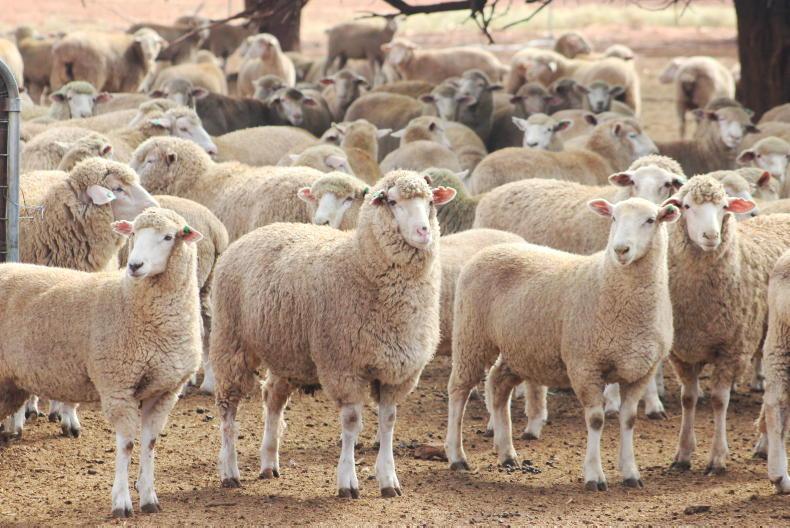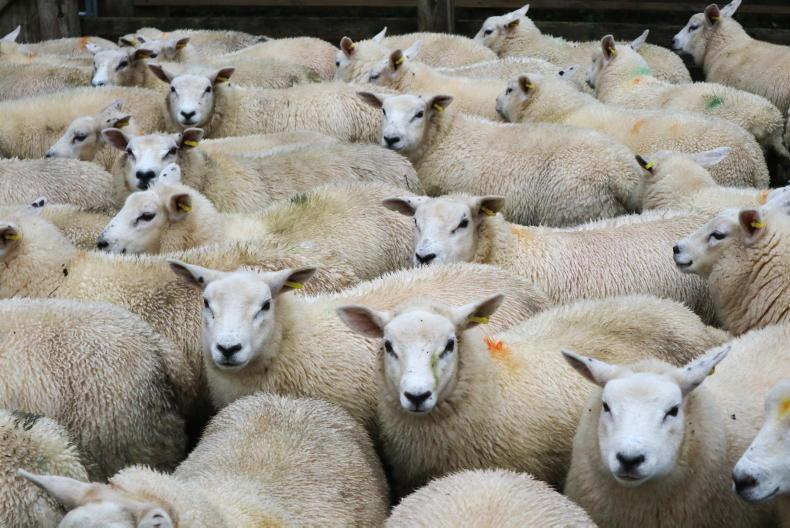The Irish sheep sector’s long wait to regain access to the US sheepmeat market has finally taken a significant step closer to fruition, following last week’s announcement that the US has lifted its ban on sheepmeat exports from the EU.
Minister for Agriculture Charlie McConalogue has heralded the announcement as paving the way for full market access for Irish sheepmeat.
The US sheepmeat market is miniscule when compared to other meat proteins.
Per capita consumption of poultry is estimated to be in excess of 50kg, with beef consumption in excess of 25kg and pork in the region of 23kg. This compares to just 0.4kg to 0.5kg for sheepmeat.
While consumption of sheepmeat is small, the vast size of the US population means that total consumption is still significant and was recorded in the region of 194,000t in 2020. The market has recorded positive growth in recent years, increasing at a rate of 2% to 3% per annum.
At the same time, domestic production has been trending in the opposite direction and this is fuelling import demand.
As will be discussed in greater detail, sheepmeat imports have increased by in the region of 60,000t over the last decade. To put the scale of this increase in context, it is not far off the total level of 75,000t of sheepmeat exported from Ireland in 2020.
Domestic production in decline
The US sheep sector has mirrored the typical global trend of numbers following a downward turn, with the extent of this decline running at a much higher level in the US.
Historically, sheep were maintained for their wool, with lamb and mutton viewed as byproducts.
The US Department of Agriculture (USDA) reports numbers standing at 45m head in 1867 when inventory data began, before peaking at 51m head in 1884.
Numbers have declined greatly since then, with demand for wool collapsing on the back of huge growth in synthetic fibres.
Figure 1 shows the scale of the decrease in the sheep population over the last two decades, with total sheep numbers falling by over 1.7m head and standing at 5.2m head in the 2020 sheep census.
Focus on imports
The decline in flock numbers has underpinned a significant decrease in domestic sheep production.
As demonstrated in Figure 2, sheep production has fallen from over 100,000t in 2001 to over 64,000t in 2020. Part of the decline seen in the early 2000s was due to a steady live import trade from Canada dissipating.
During the same timeframe, sheepmeat imports have increased by 70,000t, with import requirements intensifying since 2016 and rising in the last five years by close to 30,000t. Forecasts indicate that the recent growth in consumption of 2% to 3% per annum will continue until at least 2025.
The upward momentum in sheepmeat imports in recent years is better detailed in Figure 3, which breaks down sheepmeat imports by lamb and mutton.
Bord Bia highlights that the value of sheepmeat imports was worth €883m in 2020, with imports on track to at least replicate and possibly exceed this performance in 2021.
Australia is the main beneficiary of this increase in consumption and accounts for in the region of 75% of import volumes. New Zealand makes up the majority of the balance, with volumes running in the region of 23% of imports in recent years, with the remaining 2% supplied by a number of other countries including Uruguay and Chile.
Consumption trends
The USDA reports that the decline in sheepmeat consumption over recent decades is due in part to a declining acceptance of lamb from a growing segment of the population, along with intense competition from the other meat proteins.
Consumer preference is for high-quality cuts such as lamb legs and loins.
It states that the northeast, which has a high concentration of Middle Eastern, Caribbean and African consumers, is a major market for lamb products. The typical lamb consumer is described as an older, relatively well-established individual who lives in metropolitan areas such as New York, Boston, or Philadelphia in the northeast, or in San Francisco or Los Angeles on the west coast.
Consumer surveys do, however, point to some growth in consumption in younger consumers, with this driven by the use of lamb in convenience and street foods.
US sheep production system
The makeup of the sheep flock is hugely diverse, compromising a large number of farms keeping very small numbers and a few large-scale flocks. The USDA reports that the number of farms keeping sheep reduced from over 100,000 in the 1990s to less than 80,000 in 2012, before increasing again to over 101,000 farms keeping sheep in 2017.
However, it suggests that a change to the recording procedure for small-scale producers may be responsible for capturing more of these flocks, rather than any real increase in flock numbers.
Significant-sized enterprises can be broken down in to two categories – extensive sheep units, similar to hill sheep systems here, where lambs are reared on pasture, and what is described by the USDA as range forage, some of which is arid western lands with few alternative uses.
California and other western states are home to such flocks, with two-thirds of sheep operations located in the southern plains, mountain and pacific regions.
California is second largest sheep producing state, with Texas being the largest.
Texas is home to the second type of sheep enterprise – feedlot systems with greater access to supplementary feed.
Lambs are typically raised in the more extensive sheep production enterprises
Lambs on these farms are regularly sold in to the second type of enterprises – feedlot systems located in the central plains such as Texas, where there is greater access to feed. Lambs are generally reared until they are 27kg to 36kg liveweight and then transferred to these finishing units.
Lambs are usually brought through to heavier carcase weights.
The USDA reports the average carcase weight of lambs and ewes recorded at 29kg. This tallies with the average carcase weights in Australian sheep production.
The USDA lists the current lamb price at $2.31/lb, which is the equivalent of €4.54/kg.
This is down from a peak price of €5.16/kg in July 2021 and is significantly ahead of the corresponding price of €3.29/kg in November 2020, reflecting the upward movement in global sheep prices.
Lifting of EU sheepmeat ban
The EU-wide ban on sheepmeat exports to the US has been in place for about three decades and was introduced following the identification of scrapie in sheep flocks in a number of EU member states.
The disease is similar to BSE in cattle and the BSE scare in the late 1990s did not help the manner in which US authorities viewed EU sheepmeat exports.
There were strong hopes for the industry in 2015, following Ireland being the first EU member state to regain access for beef exports following a 15-year hiatus, that sheepmeat exports would soon follow.
However, this did not materialise and the sector has been left frustrated ever since. Reports indicate that the main reason for the delay was the fact that sheepmeat access was dealt with on an EU-wide basis, as opposed to individual countries negotiating with the US.
It is important to note that the removal of the ban is EU wide, while the UK had its ban lifted in September 2021. This means that the US market is also open to exports from the UK and other sheep-exporting nations in Europe, such as Spain.
However, the fact that supplies of sheepmeat are tight in the UK and production is declining in almost all other European countries will limit competition. The US market will not turn in to a market accounting for high volumes of sheepmeat exports overnight, but once open, it will provide another potential high-value outlet for Irish processors to tap in to.

Lamb ewes and ewes on Tullamore Farm October 2020. \ Philip Doyle
If we use the Canadian market as an example of what can be delivered, the market opened in 2015, and over a number of years since, has imported in the region of 1,000t of Irish sheepmeat. A strong Irish diaspora in the US is said to offer positive market demand and it is important that the first step in gaining market access is now built upon.
Minister for Agriculture Charlie McConalogue said: “This announcement represents the removal of a major impediment to access to the US market. This development is very significant and paves the way for full market access for Irish sheepmeat.
“My department, in collaboration with the Embassy of Ireland in Washington, has worked hard over several years to ensure that the ban was lifted.
“We will now engage with US authorities on the next steps to full access and to ensure that Irish sheepmeat exports to this valuable market will be able to commence as soon as possible. This is an important recognition of the hard work our sheep farmers carry out in producing a top-quality product.”
Bord Bia’s chief executive Tara McCarthy said: “Bord Bia is delighted with the prospect of promoting sheepmeat to the US in the coming months. Our focus will be on raising the profile of Irish grass-fed sheepmeat through awareness of it as a premium, natural product sourced from Quality Assured farms, and fully traceable from farm to fork.”
Bord Bia US manager, Henry Horkan commented: “This is vital at a time when diversification into international markets has never been more important to optimise the value returned to Irish producers. Next spring, the Department of Agriculture, Food and the Marine will lead a trade mission with Bord Bia to the US, which will include a series of lamb focused meetings with key importers”.
Meat Industry Ireland (MII) representing the country’s main sheepmeat processing companies said: “Processors have an ambition to drive international market access for Irish sheepmeat and the US market has been one of our key target markets for many years. Securing access to the US market will be a positive step for the Irish sheepmeat sector. We look forward to seeing high-quality, sustainably-produced Irish lamb on the market in the US as soon as possible.”
“MII and its members will work with the Department of Agriculture to finalise the necessary steps, including finalisation of a veterinary certificate, US-specific requirements and plant inspections, so that trade can commence.”
The Irish sheep sector’s long wait to regain access to the US sheepmeat market has finally taken a significant step closer to fruition, following last week’s announcement that the US has lifted its ban on sheepmeat exports from the EU.
Minister for Agriculture Charlie McConalogue has heralded the announcement as paving the way for full market access for Irish sheepmeat.
The US sheepmeat market is miniscule when compared to other meat proteins.
Per capita consumption of poultry is estimated to be in excess of 50kg, with beef consumption in excess of 25kg and pork in the region of 23kg. This compares to just 0.4kg to 0.5kg for sheepmeat.
While consumption of sheepmeat is small, the vast size of the US population means that total consumption is still significant and was recorded in the region of 194,000t in 2020. The market has recorded positive growth in recent years, increasing at a rate of 2% to 3% per annum.
At the same time, domestic production has been trending in the opposite direction and this is fuelling import demand.
As will be discussed in greater detail, sheepmeat imports have increased by in the region of 60,000t over the last decade. To put the scale of this increase in context, it is not far off the total level of 75,000t of sheepmeat exported from Ireland in 2020.
Domestic production in decline
The US sheep sector has mirrored the typical global trend of numbers following a downward turn, with the extent of this decline running at a much higher level in the US.
Historically, sheep were maintained for their wool, with lamb and mutton viewed as byproducts.
The US Department of Agriculture (USDA) reports numbers standing at 45m head in 1867 when inventory data began, before peaking at 51m head in 1884.
Numbers have declined greatly since then, with demand for wool collapsing on the back of huge growth in synthetic fibres.
Figure 1 shows the scale of the decrease in the sheep population over the last two decades, with total sheep numbers falling by over 1.7m head and standing at 5.2m head in the 2020 sheep census.
Focus on imports
The decline in flock numbers has underpinned a significant decrease in domestic sheep production.
As demonstrated in Figure 2, sheep production has fallen from over 100,000t in 2001 to over 64,000t in 2020. Part of the decline seen in the early 2000s was due to a steady live import trade from Canada dissipating.
During the same timeframe, sheepmeat imports have increased by 70,000t, with import requirements intensifying since 2016 and rising in the last five years by close to 30,000t. Forecasts indicate that the recent growth in consumption of 2% to 3% per annum will continue until at least 2025.
The upward momentum in sheepmeat imports in recent years is better detailed in Figure 3, which breaks down sheepmeat imports by lamb and mutton.
Bord Bia highlights that the value of sheepmeat imports was worth €883m in 2020, with imports on track to at least replicate and possibly exceed this performance in 2021.
Australia is the main beneficiary of this increase in consumption and accounts for in the region of 75% of import volumes. New Zealand makes up the majority of the balance, with volumes running in the region of 23% of imports in recent years, with the remaining 2% supplied by a number of other countries including Uruguay and Chile.
Consumption trends
The USDA reports that the decline in sheepmeat consumption over recent decades is due in part to a declining acceptance of lamb from a growing segment of the population, along with intense competition from the other meat proteins.
Consumer preference is for high-quality cuts such as lamb legs and loins.
It states that the northeast, which has a high concentration of Middle Eastern, Caribbean and African consumers, is a major market for lamb products. The typical lamb consumer is described as an older, relatively well-established individual who lives in metropolitan areas such as New York, Boston, or Philadelphia in the northeast, or in San Francisco or Los Angeles on the west coast.
Consumer surveys do, however, point to some growth in consumption in younger consumers, with this driven by the use of lamb in convenience and street foods.
US sheep production system
The makeup of the sheep flock is hugely diverse, compromising a large number of farms keeping very small numbers and a few large-scale flocks. The USDA reports that the number of farms keeping sheep reduced from over 100,000 in the 1990s to less than 80,000 in 2012, before increasing again to over 101,000 farms keeping sheep in 2017.
However, it suggests that a change to the recording procedure for small-scale producers may be responsible for capturing more of these flocks, rather than any real increase in flock numbers.
Significant-sized enterprises can be broken down in to two categories – extensive sheep units, similar to hill sheep systems here, where lambs are reared on pasture, and what is described by the USDA as range forage, some of which is arid western lands with few alternative uses.
California and other western states are home to such flocks, with two-thirds of sheep operations located in the southern plains, mountain and pacific regions.
California is second largest sheep producing state, with Texas being the largest.
Texas is home to the second type of sheep enterprise – feedlot systems with greater access to supplementary feed.
Lambs are typically raised in the more extensive sheep production enterprises
Lambs on these farms are regularly sold in to the second type of enterprises – feedlot systems located in the central plains such as Texas, where there is greater access to feed. Lambs are generally reared until they are 27kg to 36kg liveweight and then transferred to these finishing units.
Lambs are usually brought through to heavier carcase weights.
The USDA reports the average carcase weight of lambs and ewes recorded at 29kg. This tallies with the average carcase weights in Australian sheep production.
The USDA lists the current lamb price at $2.31/lb, which is the equivalent of €4.54/kg.
This is down from a peak price of €5.16/kg in July 2021 and is significantly ahead of the corresponding price of €3.29/kg in November 2020, reflecting the upward movement in global sheep prices.
Lifting of EU sheepmeat ban
The EU-wide ban on sheepmeat exports to the US has been in place for about three decades and was introduced following the identification of scrapie in sheep flocks in a number of EU member states.
The disease is similar to BSE in cattle and the BSE scare in the late 1990s did not help the manner in which US authorities viewed EU sheepmeat exports.
There were strong hopes for the industry in 2015, following Ireland being the first EU member state to regain access for beef exports following a 15-year hiatus, that sheepmeat exports would soon follow.
However, this did not materialise and the sector has been left frustrated ever since. Reports indicate that the main reason for the delay was the fact that sheepmeat access was dealt with on an EU-wide basis, as opposed to individual countries negotiating with the US.
It is important to note that the removal of the ban is EU wide, while the UK had its ban lifted in September 2021. This means that the US market is also open to exports from the UK and other sheep-exporting nations in Europe, such as Spain.
However, the fact that supplies of sheepmeat are tight in the UK and production is declining in almost all other European countries will limit competition. The US market will not turn in to a market accounting for high volumes of sheepmeat exports overnight, but once open, it will provide another potential high-value outlet for Irish processors to tap in to.

Lamb ewes and ewes on Tullamore Farm October 2020. \ Philip Doyle
If we use the Canadian market as an example of what can be delivered, the market opened in 2015, and over a number of years since, has imported in the region of 1,000t of Irish sheepmeat. A strong Irish diaspora in the US is said to offer positive market demand and it is important that the first step in gaining market access is now built upon.
Minister for Agriculture Charlie McConalogue said: “This announcement represents the removal of a major impediment to access to the US market. This development is very significant and paves the way for full market access for Irish sheepmeat.
“My department, in collaboration with the Embassy of Ireland in Washington, has worked hard over several years to ensure that the ban was lifted.
“We will now engage with US authorities on the next steps to full access and to ensure that Irish sheepmeat exports to this valuable market will be able to commence as soon as possible. This is an important recognition of the hard work our sheep farmers carry out in producing a top-quality product.”
Bord Bia’s chief executive Tara McCarthy said: “Bord Bia is delighted with the prospect of promoting sheepmeat to the US in the coming months. Our focus will be on raising the profile of Irish grass-fed sheepmeat through awareness of it as a premium, natural product sourced from Quality Assured farms, and fully traceable from farm to fork.”
Bord Bia US manager, Henry Horkan commented: “This is vital at a time when diversification into international markets has never been more important to optimise the value returned to Irish producers. Next spring, the Department of Agriculture, Food and the Marine will lead a trade mission with Bord Bia to the US, which will include a series of lamb focused meetings with key importers”.
Meat Industry Ireland (MII) representing the country’s main sheepmeat processing companies said: “Processors have an ambition to drive international market access for Irish sheepmeat and the US market has been one of our key target markets for many years. Securing access to the US market will be a positive step for the Irish sheepmeat sector. We look forward to seeing high-quality, sustainably-produced Irish lamb on the market in the US as soon as possible.”
“MII and its members will work with the Department of Agriculture to finalise the necessary steps, including finalisation of a veterinary certificate, US-specific requirements and plant inspections, so that trade can commence.”












SHARING OPTIONS